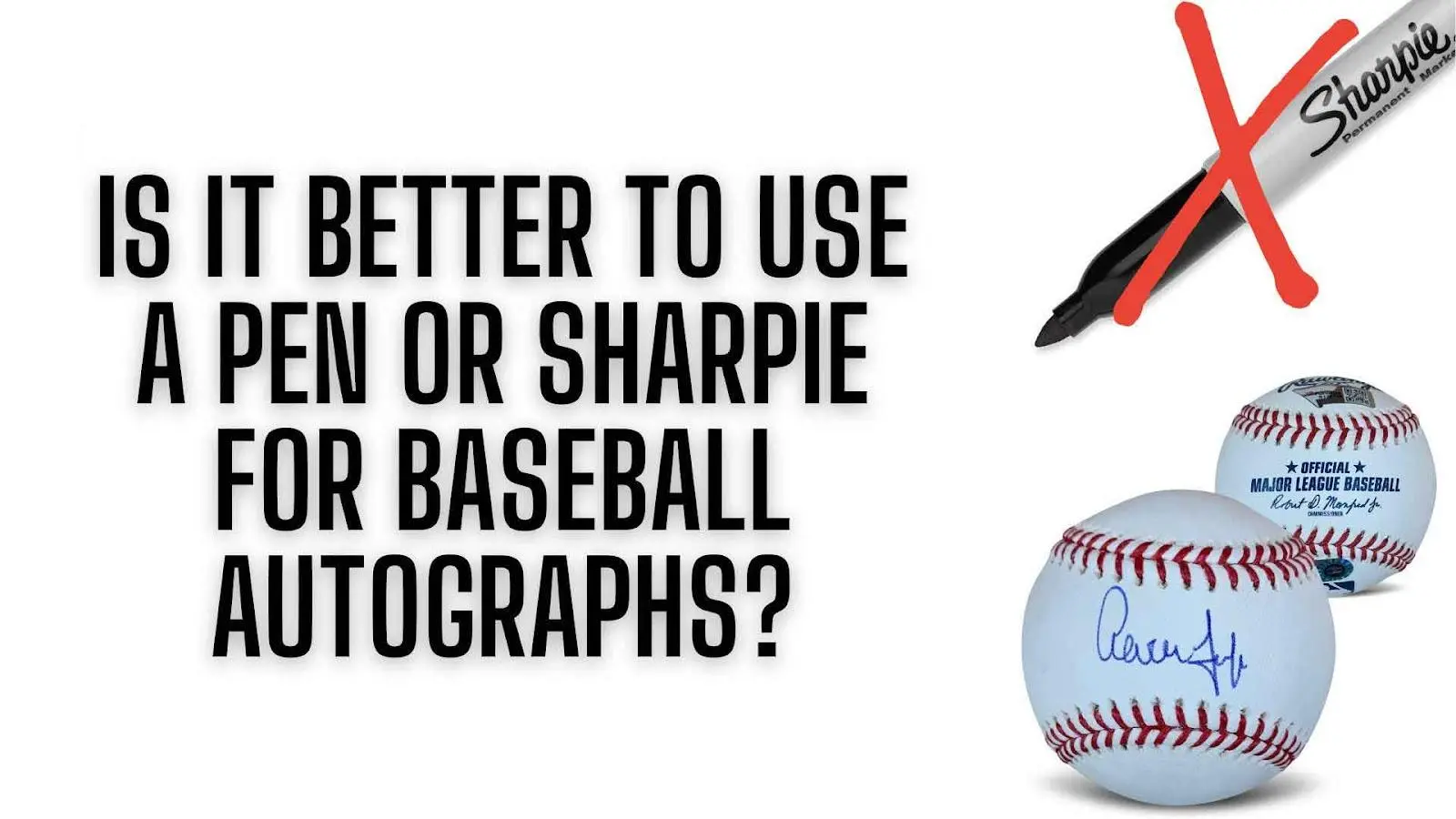As an Amazon Associate we earn from qualifying purchases. Learn More.
Recently, questions regarding signing baseball players are flowing like crazy. Hence, queries like “Is it better to use a Pen or Sharpie for baseball autographs?” are common. Let me tell you why.
See, when it comes to baseball autographs, the choice between a pen and a Sharpie is crucial. Because, depending on the situation, either one of them will work and the other one won’t.
This sparkles a debate, WHICH ONE IS THE BEST? Well, in this article, we’ll try to explore exactly this part. And find out which one is better for Baseball Autographs: a Pen or Sharpie?
Let’s get to it, shall we?
Table of Contents
Pen VS Sharpie for Baseball Autographs
A Sharpie and a pen have two different sets of unique characteristics. For this reason, the results will obviously take a detour from each other. So, for a fair comparison, I’ve taken a few aspects and tried to show which would be better in certain situations. So, let’s get to it.
Ink Composition and Durability
How does ink composition affect the durability of autographs?
Well, for Ballpoint Pens, they have Oil-based ink that provides resilience against elements. This ink resists fading which is necessary for autograph longevity. Moreover, it doesn’t bleed into the ball’s leather and preserves autograph quality.
On the other hand, Sharpie’s ink is mainly water-resistant and is known for its boldness. However, it can bleed and fade on leather, affecting autograph durability.
Surface Compatibility
Generally, a pen matches well with the leather texture of baseballs. It ensures clarity and longevity, a key for collector preference.
On the other hand, sharpie is best for photos, jerseys, and other flat, non-absorbent items. It is also excellent for memorabilia signing on suitable surfaces. Se, each gets a point here.
Color Consistency and Aesthetic of Pen and Sharpie
In pens, blue ink is chosen for its color stability and traditional appearance. It offers a classic look and enhances the value of ball autographs. Also, great to show off collections.
Sharpie provides a broader color spectrum. However, its black ink may change to purple. This will impact the aesthetic consistency.
Autograph Clarity and Legibility
In this case, pens produce sharp and detailed writings on baseballs. However, sharpie stays flat here. It gives striking results on flat surfaces. Also, you can spread it or blur it on baseballs and compromise autograph clarity.
Longevity of Autographs
A pen maintains legibility which is an important aspect of autograph longevity. You can preserve autographs over time, not just a few weeks.
However, a Sharpie is prone to fading and bleeding on leather. This can seem to be a concern for long-term preservation.
Ease of Use and Accessibility
Mainly, a ballpoint pen requires minimal pressure, reducing smudging risk. It is easy to use and post, especially for detailed signatures.
On the other hand, Sharpie’s ink dries quickly, which is beneficial for fast-paced signings. So, a sure risky thing on baseballs. It is better for other sports memorabilia.
Cost and Availability
The right Pen will generally be more affordable. Also, they’re widely available. So, a great option for anybody who is on a budget.
On the contrary, the counterpart is slightly higher priced. Many companies make different products.
Things to Consider Before Choosing a Pen for Baseball Autographs
Whether you need to sign on a card or a baseball, you must follow certain things before choosing a pen. Let’s look at those next.
UV Protection
Select pens with high lightfast ratings to ensure the autograph withstands sunlight exposure. Use UV-resistant glass or display cases to protect the autograph from fading due to UV light.
Ink Quality
Always Opt for inks known for their longevity and resistance to environmental factors. Consider water-resistant inks to prevent smudging or running in humid conditions.
Test Before Use
Always do a quick test on a similar surface or spare paper to check ink flow and color. This helps avoid unexpected issues during the actual signing. Like ink blotting or pen failure.
Bring Spares
Carry several backup pens to ensure you’re prepared for any malfunction. Include different types of pens (ballpoint, fine-tip) to accommodate the signer’s preference.
Drying Time
After the autograph, give it ample time to dry to prevent smudging. Handle the autographed item carefully immediately after signing. This will preserve the integrity of the ink.
Brand Names
Invest in pens from well-known, trusted manufacturers for consistent quality. Look for brands that are specifically recommended by collectors and autograph experts.
Color Choices
Blue, black, and silver are traditionally safe choices. They offer visibility and resistance to fading. Always use a darker shade that stands out better. This makes it ideal for long-term display. Never use lighter pens. Make sure you have the perfect one.
If you follow all the above considerations, you will find the best pen to sign on baseballs.
The Final Words
Is it better to use a Pen or Sharpie for baseball autographs? Yes, of course, it is better, if you have the right pens in your hand. To get that, I’ve dedicated the whole article. You’ll find many comparisons between pens and Sharpies.
And last, I’ve given a perfect buying guide for you to buy the next pen for better use. I believe it’ll be helpful for you. See you again!
I’m Muhammad. Ink in My Veins, Tools in My Arsenal. Don’t just call me a writer, call me your personal pen-whisperer.
Since 2015, I’ve been writing in various niches. My passion for pens, pencils, papers, binders, folders is on another level.
Remember that pen you bought after reading a promotional non-helpful online review? Felt like writing with a soggy noodle, right? Me too! That’s why I test every writing tool myself, from fancy pens to glittery highlighters.
On writersneed.com, you’ll find me reviewing the latest writing tools, sharing expert tips, and even sprinkling in some humor to keep things lively.
